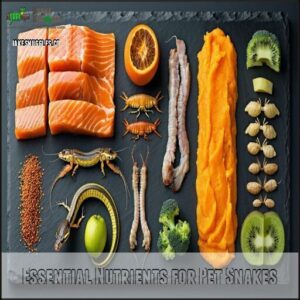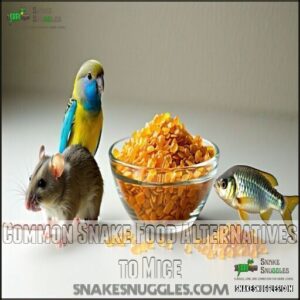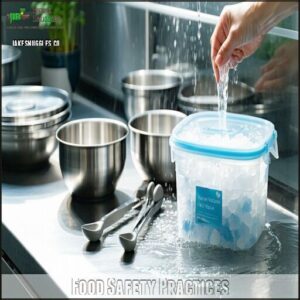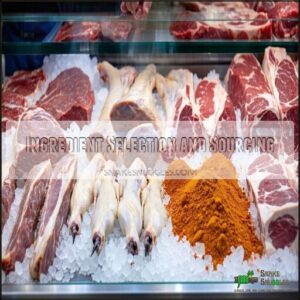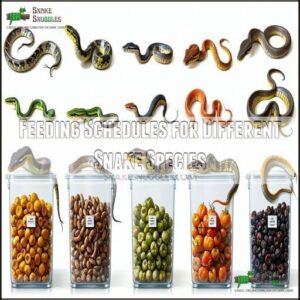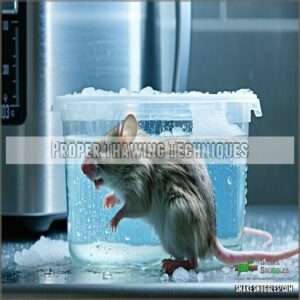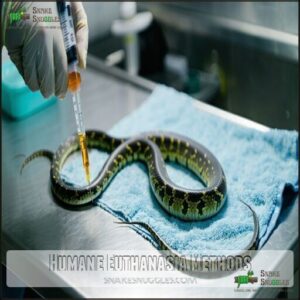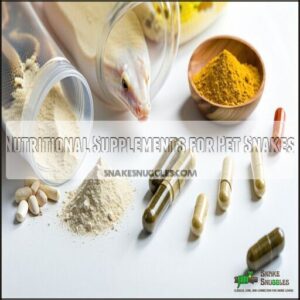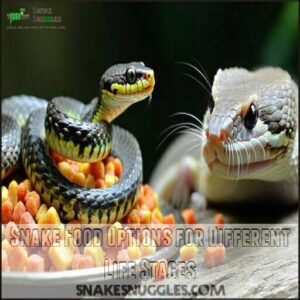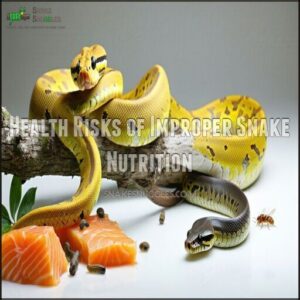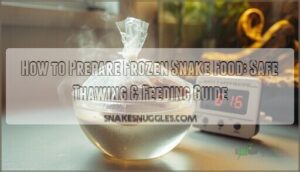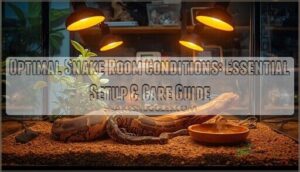This site is supported by our readers. We may earn a commission, at no cost to you, if you purchase through links.
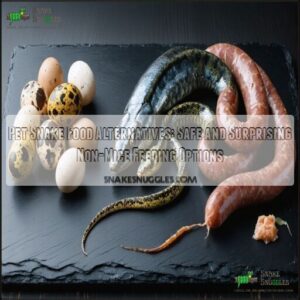
While mice are the go-to, you can mix things up with options like rats, chicks, quail eggs, or even certain fish, depending on your snake’s species.
Commercially prepared snake foods, like frozen sausages designed for reptiles, can also work well. Just make sure you’re meeting their protein, calcium, and vitamin needs.
If you’re considering something new, double-check its safety and nutritional value—snakes are picky for a reason! With the right choices, you’ll keep your snake healthy and happy.
Curious about recipes or handling tips? Stay tuned!
Table Of Contents
- Key Takeaways
- Essential Nutrients for Pet Snakes
- Common Snake Food Alternatives to Mice
- Homemade Snake Food Recipes and Preparation
- Feeding Schedules for Different Snake Species
- Safe Handling of Live Prey Alternatives
- Nutritional Supplements for Pet Snakes
- Addressing Picky Eaters and Feeding Problems
- Snake Food Options for Different Life Stages
- Sourcing Snake Food Alternatives
- Health Risks of Improper Snake Nutrition
- Frequently Asked Questions (FAQs)
- Can snakes eat anything other than meat?
- What can I feed my snake if I don’t have mice?
- What do snakes eat?
- Can a snake survive on a vegetarian diet?
- What can snakes eat besides mice?
- Do snakes eat vertebrates?
- Can snakes eat fruits and vegetables?
- Can snakes eat worms?
- What household foods can snakes eat?
- How long can a snake go without eating?
- Conclusion
Key Takeaways
- Diversify your snake’s diet with alternatives like rats, quail eggs, fish, and commercially prepared snake foods while keeping their species-specific needs in mind.
- Prioritize food safety by freezing prey to kill parasites, thawing properly, and sourcing from trusted suppliers.
- Use supplements like calcium powder and multivitamins sparingly to meet nutritional gaps and prevent issues like metabolic bone disease.
- Adjust feeding frequency and prey size based on your snake’s age, size, and life stage to maintain a healthy weight and overall well-being.
Essential Nutrients for Pet Snakes
Your snake needs a diet that provides the right balance of protein, calcium, and essential vitamins to stay healthy.
Understanding these nutrients guarantees your pet gets everything it needs for strong bones, proper digestion, and overall well-being.
Protein Requirements
Providing protein is key to your snake’s muscle development, growth stages, and overall health. Protein sources must align with their dietary balance and digestion efficiency. Animal-based foods are necessary to meet their specific snake dietary requirements.
Protein fuels your snake’s growth, health, and muscles—ensure their diet includes high-quality, animal-based sources to thrive.
Here’s a handy list of nutritious snake food for protein needs:
- Whole prey like mice or rats for most species.
- Fish for water snakes (occasionally, for variety).
- Quail eggs, a great treat for some snakes.
- Commercial snake foods designed for balanced nutrition.
- Insects (like crickets) for smaller species.
Meeting these protein needs guarantees superior snake nutrition.
Calcium and Phosphorus Balance
Strong bones need more than protein. Your snake’s ideal calcium to phosphorus ratio is 2:1, and achieving that balance is essential for MBD prevention.
Here’s a breakdown:
- Whole prey items naturally provide balanced minerals.
- Supplements like calcium powder are useful if your snake’s diet lacks variety.
- Excess phosphorus interferes with calcium absorption, leading to issues.
- Vitamin D3 allows proper calcium utilization for bone health.
Without the right balance, snakes risk signs like tremors or soft jaws. Prioritize proper snake nutrition to avoid these common issues!
Vitamins and Minerals
Your snake’s diet needs more than calcium and phosphorus for well-rounded health.
Vitamin D3 supplementation improves calcium absorption for stronger bones, while Vitamin A keeps your snake’s vision sharp and skin healthy.
Minerals like zinc and iron are equally important—supporting immunity and preventing anemia respectively.
Whole prey generally covers these needs, but picky eaters may benefit from snake vitamin supplements.
Boost mineral balance by rotating reptile calcium sources and varied diets to guarantee your snake thrives with the right mix of fatty acids, vitamins, and minerals.
Fat Content
Fats play an essential role in snake nutrition, fueling their energy and overall health.
Prey fat levels vary, so balance is key—pinkies provide ideal fat content, while leaner options might need fish oil for essential fatty acids.
Egg yolk fat and chick fat content can also enrich their diet, but watch for obesity concerns.
Monitor your snake’s body condition regularly to maintain a proper dietary balance and prevent fat-related health issues like obesity.
Common Snake Food Alternatives to Mice
If you’re looking for safe and nutritious alternatives to feeding your snake mice, there are several options to explore.
From rats and small birds to fish and even specialized commercial diets, these alternatives can meet your pet’s dietary needs while adding variety.
Rats and Other Rodents
Not all rodents are created equal in regards to feeding your snake.
While mice are common, other options can add variety and boost nutrition. Rodents like rats, gerbils, hamsters, and even guinea pigs each bring unique benefits to your snake’s diet.
- Rats: High fat and protein content, ideal for growing snakes.
- Gerbils: A novel protein source to tempt picky eaters.
- Hamsters: Compact, nutrient-rich meals.
- Guinea Pigs: Perfect for larger snakes needing hearty portions.
- Frozen Rodents: Safe and easy; avoid live prey risks.
Ethical rodent sourcing guarantees quality while reducing health risks.
Since rodent size matters, choose prey slightly wider than your snake’s girth. Frozen rodent safety is also key—thaw thoroughly before feeding.
Including these rodents makes for a balanced, nutritious menu.
Birds and Eggs
Birds and eggs are fantastic additions to a snake’s diet, offering variety and nutrients you won’t get from rodents.
Day-old chicks, with their high protein content, can be a great option for larger snakes, while quail and finches cater to smaller or specialized feeders.
Quail eggs stand out for their balanced nutrition and practicality, especially for egg-eating snakes.
If you’re feeding birds like chickens, trim wings or feet off larger fowl to avoid injury.
While eggs and chicks bring calcium and diversity to the table, they’re no substitute for a balanced diet.
Mix them in sensibly for a happy, healthy snake!
Fish and Amphibians
If you want to explore varied reptile diet options, fish and amphibians offer valuable alternatives for certain species. Garter and ribbon snakes, in particular, may enjoy these aquatic prey items as part of their natural preferences.
When adding fish to your snake’s menu, it’s important to address Thiaminase Risks and prevent Fish Parasites. Stick to safer choices like tilapia or silversides instead of goldfish.
To protect your snake’s health, follow these steps:
- Freeze fish for 48 hours to kill harmful parasites.
- Avoid wild-caught specimens, which may introduce diseases.
- Dust fish with calcium powder for a balanced diet.
- Feed appropriately-sized prey—no wider than 1.5 times your snake’s midsection.
For amphibians, be wary of Amphibian Toxins or parasites from wild frogs or toads. Captive-bred amphibians offer safer, enriching snake food alternatives, especially for ribbon or water snakes requiring aquatic enrichment. Always research your species’ specific needs.
Commercially Prepared Snake Foods
Commercial snake foods offer hassle-free pet snake food alternatives, giving you options that are convenient and nutritionally complete.
These products remove the stress of handling live prey while guaranteeing your snake’s health.
Here are 4 key commercial snake food options:
- Frozen prey items – These provide a balanced diet and are easy to thaw.
- Freeze-dried prey – Lightweight and reconstituted easily with water, great for storage.
- Pellet food – Packed with vitamins and minerals, ideal for supplementing your snake’s nutrition.
- Powdered diets or canned options – Convenient and formulated to mimic whole prey.
Commercial reptile foods save you from stocking rodents in your freezer and reduce feeding anxieties.
Many owners prefer pre-killed frozen options for convenience.
When buying, compare brands to confirm freshness and quality.
Fortified with calcium and essential nutrients, these snake food substitutes make feeding stress-free, practical, and safe for your snake’s unique dietary needs.
Homemade Snake Food Recipes and Preparation
When making your own snake food, it’s vital to focus on balanced nutrition and safe preparation methods.
By selecting the right ingredients and following proper guidelines, you can create meals that meet your pet’s needs while ensuring their health and well-being.
Nutritionally Balanced Sausage Recipes
Crafting nutritionally balanced sausage recipes for your snake is easier than you’d think! To guarantee a snake health diet, start with high-quality protein sources like quail, rabbit, or fish.
Blend ground meat with about 10-15% organ meats—such as liver, heart, or kidney—for vitamin enrichment and flavor. Add a calcium addition (maintain a 2:1 calcium-to-phosphorus ratio) using bone meal or snake dietary supplements, which helps prevent metabolic bone disease.
Shape the mixture into small, snake-appropriate portions. Briefly boiling these sausages kills surface bacteria—vital for safety. Freeze immediately for long-term storage.
Recipe variety promotes snake dietary balance while serving as a convenient substitute for whole prey. Sausage ingredients allow for creative snake food substitutes designed to meet your reptile’s nutritional needs!
Food Safety Practices
Keeping your snake healthy starts with smart food safety practices.
Here’s how you can guarantee safe handling and reduce risks like parasitic infections from prey:
- Sanitize thoroughly: Wash your hands and disinfect all surfaces before and after preparing snake meals. A clean workspace matters!
- Store properly: Use vacuum-sealed bags for prey storage, freeze immediately, and label with dates. Proper rotation keeps food fresh.
- Thaw carefully: Skip the microwave; it’s unsafe. Rely on refrigerator thawing techniques to prevent bacteria growth.
Following these steps guarantees parasite prevention, safe handling, and your reptile’s lasting health.
Ingredient Selection and Sourcing
Quality ingredients are key to keeping your snake healthy and happy. Start by sourcing ethically from reputable suppliers who focus on lean meats, organ cuts, or suitable fish species.
Check for nutrient density—a balance of protein, fat, and key vitamins—that matches your snake’s needs. Frozen vs. live prey is always safer and easier to control for parasites.
Look for sustainable options like farm-raised, organic alternatives. Local butchers may offer fresher options, while online specialty retailers bring convenience for finding diverse snake dietary alternatives, like chicks or quail.
Many owners source food from online reptile suppliers for convenience. Prioritize ethical sourcing; frozen prey from reliable reptile food sources guarantees humane practices and higher quality.
Plenty of breeders at reptile expos share tips if you’re new to sourcing alternative snake prey. Choosing the right supplies is an investment in your snake’s long-term health.
Storage and Preservation Methods
Storing your snake’s food correctly keeps each meal safe and nutritious. Whether it’s frozen prey or alternative snake prey, proper methods matter.
Use airtight containers and label them with dates for efficient food rotation. Freezing techniques like vacuum sealing greatly extend the shelf life of frozen-thawed prey while preserving freshness.
For short-term use, refrigeration works well but watch for excess moisture to avoid spoilage. Dehydration methods are perfect for long-lasting reptile food sources, while canning options offer convenience.
Here’s a quick rundown of storage tips:
- Freeze prey immediately in airtight bags
- Vacuum-seal for maximum lifespan
- Label with dates to guarantee freshness
- Dehydrate when possible
- Monitor temperatures reliably
Feeding Schedules for Different Snake Species
Feeding schedules vary depending on your snake’s species, size, and age, so it’s important to know what’s best for your pet.
Adjusting meal frequency helps maintain their health and guarantees they’re neither overfed nor underfed, which is crucial for their overall well-being.
Ball Python Feeding Frequency
Your ball python’s feeding schedule depends on its life stage and needs.
Age plays a big role in determining snake feeding frequency:
- Juveniles eat every 5-7 days to fuel growth.
- Sub-adults slow down, needing meals every 7-10 days.
- Adults, with stable activity levels, eat every 10-14 days.
- Breeding females may need more frequent meals.
- Older snakes, often less active, may eat every 2-3 weeks.
Always adjust based on weight, prey size, temperament changes, and health.
Corn Snake Dietary Needs
Adult corn snakes eat every 7–10 days, while juveniles thrive on meals every 5–7 days.
Always pick prey about as wide as your snake’s middle section to prevent overfeeding or Corn snake obesity.
For a healthy wild corn diet-inspired meal plan, try:
- Hatchling corn diet: Pinkie mice.
- Adult corn diet: Larger mice or small fish like guppies.
- Dietary supplementation: Dust prey with calcium powder to support bones and avoid metabolic bone disease.
Keep pet snake food enriching!
King Snake Feeding Habits
King snakes thrive on a captive diet variety that mimics their wild prey diversity.
In nature, their menu includes snakes, lizards, and small mammals. Captive king snakes typically enjoy rodents like mice or rats, as long as the prey doesn’t exceed their midsection’s width.
For juvenile king snakes, feeding every 5–7 days works well, while adults can wait 7–14 days between meals.
Alternative snake food, like quail eggs or frozen/thawed chicks, supports egg-eating behavior and enriches their diet, meeting essential snake dietary needs and feeding habits naturally, including wild prey diversity, captive diet variety, and essential snake dietary needs.
Boa Constrictor Meal Sizes
Boa constrictors thrive when you match their prey size to their body.
Offering meals that are too large or frequent can harm growth or cause obesity.
Follow these prey size guidelines:
- Young boas: Feed prey 10-15% of body weight every 7-10 days.
- Sub-adults: Prey should be 7-10% of body weight every 10-14 days.
- Adults: Meals at 5-7% body weight work every 2-4 weeks.
- Breeding females: Increase food to 10% during breeding.
Use prey no bigger than 1.5 times your boa’s mid-body width to prevent health risks.
Safe Handling of Live Prey Alternatives
When handling live prey alternatives, you’ll need to focus on preparation and safety to protect both you and your snake.
Proper techniques, like thawing frozen prey and preventing injuries, guarantee feeding stays safe and stress-free.
Proper Thawing Techniques
Preparing frozenthawed options correctly keeps your snake healthy and guarantees safe feeding.
Avoid bacterial growth and nutritional loss by following these thawing methods:
- Skip the microwave—it heats unevenly, leaving hotspots.
- Thaw prey in warm water for quick, safe temperatures.
- Don’t refreeze prey to maintain quality.
- Use thawed prey promptly to reduce risks.
Properly thawing mice enhances digestion and supports clean snake feeding techniques!
Avoiding Prey-Induced Injuries
To avoid injuries during snake feeding, choose prey no larger than the widest part of your snake.
Use feeding tongs for frozen-thawed prey to guarantee safe handling and supervise feeding sessions.
Separate the feeding environment to reduce stress and accidental strikes.
Swap live prey with frozen options or other live prey alternatives to enhance snake feeding safety while protecting your pet’s health.
Humane Euthanasia Methods
Handling live prey demands care to guarantee ethical and humane euthanasia.
Choosing the right method depends on your skill and the prey size. Popular methods include:
- CO2 Euthanasia: Quick and efficient, ideal for small prey.
- Cervical Dislocation: Requires practice but guarantees instant results.
- Anesthetic Overdose: A calmer approach, suitable for larger prey.
Always consider Euthanasia Solutions, ethical practices, and local laws when selecting methods for your snake’s welfare.
Legal Considerations for Live Feeding
Feeding live prey comes with responsibilities. Understand Live Feeding Laws and Wildlife laws to guarantee compliance. Some areas require exotic permits for certain prey, and local ordinances might restrict live feeding practices.
Here’s a quick guide:
| Consideration | Why It Matters | Action Required |
|---|---|---|
| Animal cruelty laws | Ensures prey welfare | Verify local regulations |
| Feeding regulations | Promotes safe feeding | Follow guidelines |
| Ethical sourcing | Protects ecosystems | Buy from trusted suppliers |
Always prioritize safety and liability insurance where applicable.
Nutritional Supplements for Pet Snakes
Ensuring your pet snake gets all the essential nutrients sometimes means adding supplements to their diet.
Calcium powders, reptile multivitamins, and gut-loaded prey can help fill gaps and support their overall health.
Calcium Powder Supplementation
Calcium powder supplementation is a small step with big benefits for your snake’s health.
To maximize results:
- **Pick the right powder.
Choose a clean USP-grade calcium supplement for safety and quality.
- **Dust lightly.
Coating prey gently avoids over-supplementation risks and maintains balanced calcium-to-phosphorus ratios.
Consistency matters! Calcium powder paired with vitamin D3 guarantees absorption, safeguarding your snake from metabolic bone disease.
Proper supplementation guarantees a healthy mineral balance for your snake.
Use sparingly, monitor their response, and watch for stronger bones—it’s a no-brainer solution for keeping their skeletons in good shape.
Multivitamin Products for Reptiles
Adding multivitamins to your snake’s diet fills gaps in vitamins and minerals, supporting health and preventing issues like vitamin deficiencies.
Look for species-specific multivitamins and high-quality ingredients.
Follow dosage and frequency instructions carefully—too much can be harmful.
Products with Vitamin D3 needs in mind are key, aiding calcium supplement absorption.
Consider snake multivitamin products to guarantee proper nutrition.
Stick to trusted reptile vitamin types to avoid over-supplementation risks.
Gut-Loading Prey Animals
If you’re aiming for healthier meals for your snake, gut-loading prey animals is a game-changer.
This technique boosts prey nutrition and guarantees your snake gets the nutrients it needs.
Follow these steps to achieve optimal gut-load:
- Provide leafy greens like kale or collards.
- Add calcium-rich veggies, such as squash.
- Use commercial gut-loads for extra nutrients.
- Include fruits like apples to enhance vitamins.
- Sprinkle feed supplements before offering prey.
Better-fed prey means better-fed snakes!
Balancing Supplements With Whole Prey
Pairing nutritional supplements with whole prey creates a winning formula for snake nutrition. You’re not just feeding your pet; you’re fine-tuning their health!
Sprinkle supplements smarter to avoid over-supplementation risks. Focus on nutrient bioavailability, ensuring your snake absorbs what it needs. A dust of calcium powder promotes bone health, and vitamin D3 helps metabolize it. Gut-loading prey boosts natural enrichment, delivering nutrients directly.
| Supplement | How Often | Why Use |
|---|---|---|
| Calcium Powder | Every 2 meals | Strong bones, muscles |
| Multivitamin | Monthly | Prevent deficiencies |
| Vitamin D3 | Monthly (if needed) | Calcium absorption |
| Gut-Loaded Prey | Every meal | Nutrient bioavailability |
Rotate wisely for balanced reptile nutrition!
Addressing Picky Eaters and Feeding Problems
If your snake refuses food, it’s often a sign of stress, or unfamiliar prey.
By adjusting environmental factors and offering creative alternatives, you can encourage healthier and more consistent feeding behavior.
Scent Transfer Techniques
If your snake’s ignoring meals, scent transfer may save the day by reawakening their appetite using familiar smells and cues.
Snakes rely heavily on scent for hunting, and introducing odors they recognize can help convince a picky eater to strike.
Here are some effective methods:
- Scent masking with bedding: Rub prey in bedding from frogs, lizards, or rodents to layer the food with familiar scents.
- Prey scenting with sardines: Lightly coat prey with sardine juice or fish oil to make it smell irresistible.
- Trail odors from other animals: Use soiled materials from prey cages to create pheromone trails that mimic hunting scenarios.
These scent association techniques tap into natural instincts, turning uncertain snakes into enthusiastic feeders.
Temperature and Humidity Adjustments
Sometimes it’s all about minor tweaks.
Temperature and humidity adjustments can do wonders for a reluctant feeder. Snakes thrive with proper heating gradients and humid conditions that mirror their native habitats.
Set up a basking spot for daytime warmth, with cooler areas for regulation, and let nighttime drops mimic natural cycles. Use multiple thermometers and hygrometers to check accuracy.
Seasonal changes may require tweaking heat control or misting to increase humidity levels. When you meet their environmental needs, their appetite often kicks in.
A well-tuned setup encourages healthier eating habits and acceptance of non-mice food alternatives, leading to a more balanced environment.
Stress Reduction Strategies
Stress can turn even the hungriest snake into a picky eater. Focus on stress reduction to encourage feeding.
- Minimize handling before meals and stick to consistent feeding rituals.
- Optimize the habitat with secure hiding spots, climbing branches, and the optimal temperature range for their species.
- Add enclosure enrichment like new textures or non-toxic scent trails to ignite natural hunting instincts.
Also, keep the environment calm. Try reducing noise, lowering vibrations, and giving them private feeding time. With patience and these adjustments, most snakes will feel secure enough to eat comfortably.
Assisted Feeding Methods
If your snake refuses food, assisted feeding methods can help.
After reducing stress, try these proven techniques:
- Tong Feeding: Use tongs to wiggle prey lightly, mimicking natural movements. This activates hunting instincts.
- Assist Feeding: If still refusing, open the snake’s mouth gently and place food near its throat. Avoid forcing as it adds stress.
- Tube Feeding: In emergencies, veterinarians use tube placement or gavage techniques. Syringe feeding delivers direct nutrition.
Scenting food with familiar smells or target training encourages self-feeding over time. Variety in prey can also stimulate appetite.
Always identify refusal causes before resorting to assisted feeding.
Snake Food Options for Different Life Stages
Feeding your snake the right diet depends on its life stage, as nutritional needs change over time.
Hatchlings, adults, breeding females, and older snakes all require specialized food options to stay healthy and thrive.
Hatchling and Juvenile Diets
What should you know about hatchling and juvenile diets?
First meals are vital for a growing snake’s health.
Your snake’s prey should always be smaller than the broadest part of its body.
Hatchlings thrive on pinkie mice, small fish options, or even earthworms, fed every 5-7 days during early growth stages.
As juvenile snakes develop, introduce variety like fuzzy mice, gut-loaded insects, or small amphibians.
This helps avoid picky eating habits while ensuring balanced nutrition.
Growth stages are the perfect time to reinforce proper feeding habits.
And don’t forget—you might need supplements to meet their dietary needs fully.
Adult Snake Nutritional Requirements
Adult snake nutritional requirements change as they grow, so careful attention to their diet is key. Focus on prey gutload and dietary variety for ideal health.
Prey size should match 1-1.5 times the widest part of your snake’s body. Avoid obesity risks by monitoring feeding frequency and adjusting portions based on species and activity level.
Here’s what to keep in mind:
- Stick to prey that aligns with your snake’s natural diet.
- Balance nutrients with supplement timing as needed.
- Maintain hydration needs to support digestion.
- Incorporate dietary variety for enrichment and wellness.
Breeding and Gravid Female Nutrition
Breeding females need an enhanced gestation diet. During this time, prioritize nutrient-dense prey items like rats or feed smaller snakes calcium-dusted mice.
Calcium needs are high for egg development, so regular calcium supplements are necessary. Adjust feeding frequency as gravid snakes might eat more or less.
Proper postpartum nutrition supports maternal health and promotes neonate health. Remember, meeting these needs helps your snake thrive through reproduction.
It’s also important to take into account essential vitamin supplementation during this period for superior reproductive health.
Geriatric Snake Dietary Considerations
As snakes age, their bodies slow down, and their needs shift.
Geriatric snake dietary considerations prioritize a gentler approach to feeding.
- Adjust portion sizes to prevent obesity as metabolism slows.
- Focus on prey with lower fat content, like quail over mice.
- Extend feeding intervals to promote healthy digestion, spacing meals every 2-3 weeks.
- Introduce senior-focused supplements for joint health and support.
Think softer foods, hydration importance, and moderation.
Thoughtful changes in your snake’s diet keep them thriving through their golden years.
Sourcing Snake Food Alternatives
You’ve got plenty of options regarding finding food alternatives for your pet snake.
From reliable online retailers to local shops and reptile expos, it’s important to choose sources that prioritize quality and safety.
Online Reptile Supply Retailers
Online reptile supply retailers are a go-to for sourcing reliable food sources with minimal hassle.
These stores offer a broad product variety, including quail eggs, frozen fish, and reptile sausages, delivered to your door.
Focus on:
- Retailer reputation: Check customer reviews for freshness and ethical sourcing.
- Shipping costs and quality: Confirm temperature-controlled delivery.
- Supply chains and control: Confirm high standards for prey handling.
- Customer service: Look for shops offering guidance on snake nutrition.
Convenient subscription plans and bulk discounts can also save you effort and money.
Local Pet Stores and Specialty Shops
Local pet stores and specialty shops offer the kind of hands-on experience online reptile supply retailers can’t match.
With reliable food sources like frozen rodents, quail eggs, or silversides fish, you’ll find options to suit any snake’s diet. Local availability means seeing the quality firsthand, ensuring freshness and avoiding surprises.
Plus, knowledgeable staff provide expert advice on safe feeding and ethical sourcing practices.
Pricing comparison is easier too—local shops often feature special deals or partnerships with breeders. A store’s reputation speaks volumes, so check reviews to find trusted guidance for your pet snake’s needs.
Reptile Expos and Conventions
Exploring reptile expos can open doors to snake feeding options you never knew existed.
These events offer unmatched variety in snake food alternatives and more. You’ll gain access to:
- Vendor selection for fresh-frozen prey and unique offerings.
- Educational seminars on snake care and feeding techniques.
- Live demonstrations showcasing handling and feeding tips.
- Networking opportunities with enthusiasts and experts.
These events may also provide access to essential reptile supplies for your pet.
Local reptile expos are practical for sourcing between online orders, blending learning and community engagement.
Breeding Feeder Animals at Home
Breeding feeder animals at home is a cost-effective way to guarantee your snake’s meals are high quality and safe.
Focus on space requirements, breeding ethics, and disease prevention when setting up housing.
Use nutritious feed and perform regular health monitoring to maintain a thriving colony.
Prioritize genetic diversity by carefully selecting breeding stock, whether raising rodents or insects, this hands-on approach gives you peace of mind and control over nutrition.
Health Risks of Improper Snake Nutrition
Feeding your snake the wrong diet can lead to serious health problems like weak bones, obesity, or vitamin deficiencies.
It’s essential to understand their nutritional needs to avoid issues that could impact their overall health and longevity.
Metabolic Bone Disease
Preventing metabolic bone disease (MBD) is key for keeping your snake healthy. This condition arises from calcium deficiency, D3 supplementation issues, or a phosphorus imbalance.
Keep your snake healthy—prevent MBD with balanced calcium, proper supplements, and a diet tailored for strong bones and vitality.
Watch for these signs:
- Soft bones or jaws, making chewing difficult.
- Spinal deformities, such as a curved spine.
- Muscle tremors or weakness during movement.
Focus on proper calcium-to-phosphorus ratios in prey, using USP-grade calcium powder if needed. UV lighting supports healthy bone structure by aiding vitamin D3 synthesis. Manage diet and environment carefully to prevent nutrient imbalances or mineral deficits leading to MBD.
Obesity and Underfeeding
Striking the right balance is key to avoiding obesity-related issues or snake malnutrition.
Regular weight assessment and monitoring your snake’s body condition are vital. Feeding adjustments like matching prey size to your snake’s species, life stage, and activity level can help maintain ideal weight.
Underfeeding or overfeeding causes serious health consequences, so stay cautious. Weight management isn’t guesswork; track feeding schedules and portion sizes to guarantee a healthy body condition for your slithery friend, which requires careful weight assessment and feeding adjustments.
Vitamin Deficiencies
Poor shedding or a sluggish snake might mean vitamin deficiencies are to blame.
Without vitamin D3, calcium absorption stalls, leading to weaker bones.
A lack of B1 (thiamin) from thiaminase-heavy fish can cause neurological issues, while insufficient vitamin A impacts vision and skin health.
These deficiency symptoms harm snake health by disrupting scales, energy, and even immune functions.
Prevent snake malnutrition by feeding nutritionally complete prey or dusting food with quality supplements.
Gut-loaded feeders guarantee your snake meets its nutritional requirements, while too much supplementation risks imbalance.
Stay vigilant about balanced diets for peak snake health and vibrant appearance.
Parasitic Infections From Prey
A healthy snake starts with smart food choices.
Parasitic infections can hitch a ride on live prey, undermining your snake’s health.
Protect them with these steps:
- Parasite identification: Source feeders from trusted suppliers who test for parasites regularly.
- Prevention methods: Freeze rodents for 30 days to kill invasive parasites.
- Skip wildcaught prey: Avoid the zoonotic risks from wild prey that could carry harmful diseases.
These simple methods guarantee your snake’s diet doesn’t become a health hazard.
Frequently Asked Questions (FAQs)
Can snakes eat anything other than meat?
Snakes are strict carnivores—think of them as nature’s devoted meat lovers.
They rely on animal-based diets like rodents, birds, and insects.
Unlike us, they can’t process plant-based foods or survive on anything but meat.
What can I feed my snake if I don’t have mice?
You can offer your snake alternatives like fish (thiaminase-free options), quail eggs, or earthworms, depending on the species.
Chicks, amphibians, or insects may also work, but always research and avoid replacing rodents entirely, and consider alternatives that meet your snake’s nutritional needs.
What do snakes eat?
Think of your snake’s menu as nature’s buffet—it thrives on whole prey like mice, rats, or chicks.
Some eat fish, eggs, or insects, but sticking to their natural diet guarantees a healthy, happy reptile.
Can a snake survive on a vegetarian diet?
A vegetarian diet can’t sustain a snake.
They rely on animal-based protein to survive, as plant matter lacks essential nutrients.
It’s like asking a lion to eat salad—it just doesn’t match their biology.
What can snakes eat besides mice?
If mice feel like a broken record, try quail eggs, chicks, earthworms, or fish sparingly.
Rodents still rule for nutrition, though.
Focus on safety and variety while staying true to your snake’s natural tastes.
Do snakes eat vertebrates?
Snakes often eat vertebrates like rodents, birds, amphibians, and lizards, depending on the species.
Their diet includes prey with bones, muscles, and organs, providing essential nutrients like calcium, protein, and vitamins to support their health.
Can snakes eat fruits and vegetables?
Snakes can’t digest fruits or vegetables since their bodies aren’t built for it.
They’re strict carnivores, relying on whole prey like rodents or birds for essential nutrients, so fruits and veggies simply don’t belong in their diet.
Can snakes eat worms?
Worms might seem like a wriggly buffet for some snakes, but they’re not ideal for all species.
While garter and ribbon snakes enjoy them occasionally, worms lack key nutrients, so don’t make them the main dish!
What household foods can snakes eat?
Your snake might enjoy quail eggs or frozen/thawed fish like trout or tilapia as occasional treats.
However, don’t rely on these daily since snakes thrive best on their typical whole-prey diet of rodents.
How long can a snake go without eating?
Most snakes can go weeks or even months without eating, depending on their species, size, age, and health.
While some need regular meals, others, like ball pythons, tolerate longer fasting periods easily.
Conclusion
Choosing the right pet snake food alternatives guarantees your snake gets the nutrition it needs without relying on mice alone.
Explore safe options like rats, chicks, quail eggs, or specific fish, keeping your snake’s species and nutritional requirements in mind.
Commercially prepared foods are also a great, convenient choice, and by diversifying their diet thoughtfully, you’ll promote your snake’s health and happiness.
Always prioritize food safety, proper supplementation, and handling techniques to ensure a balanced, responsible way.
- https://onlinelibrary.wiley.com/doi/abs/10.1111/mec.12475
- https://journals.plos.org/plosone/article?id=10.1371/journal.pone.0148375
- https://reptile.guide/snakes-that-dont-eat-mice/
- https://pangovet.com/pet-lifestyle/snakes/snakes-that-dont-eat-mice/
- https://www.wisconsinherps.org/educational-articles/snakes-that-do-not-eat-rodents

